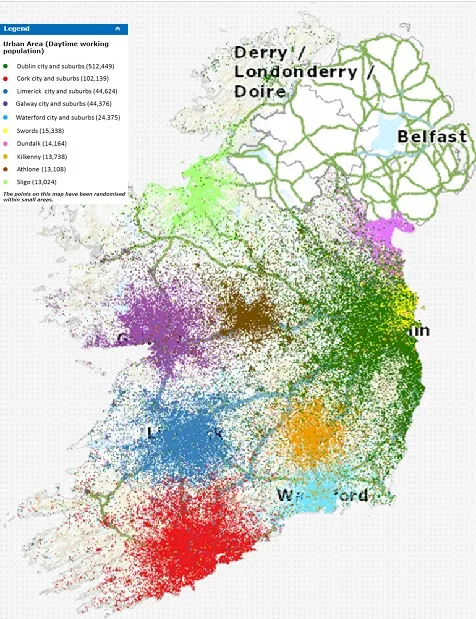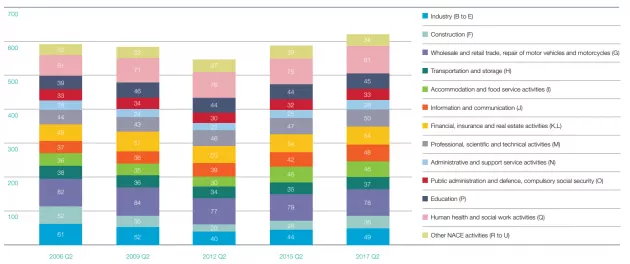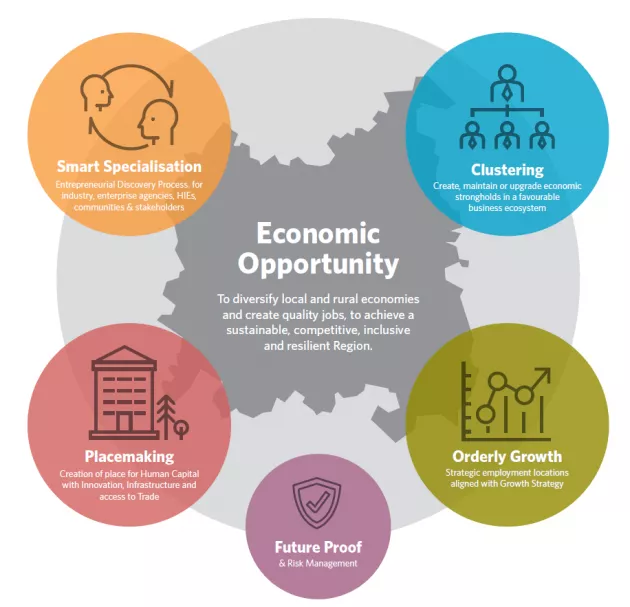6.1 - Introduction
6.1 - Introduction
Ireland’s Internationally Competitive Capital
Dublin is an international city and gateway to the European Union for many businesses. The city region contributes significantly to the Ireland’s economy and is a major economic driver for the country.
Dublin is seen as an attractive place to work and invest and is home to some of the most influential multinational corporations, with substantial clusters in technology and finance. The city has particular importance as an IT hub (9 out of the top 10 global tech companies are located in Dublin) and is also a centre of emerging as well as established multinationals with a thriving start-up scene.
Dublin’s economy is predominately a services based economy with that sector accounting for c.82% of the total activity while manufacturing and construction combined account for c.19%. As the State’s capital, Dublin performs a significant economic, administrative and cultural role.
Dublin is also one of the leading research, development and innovation locations in the world and has a young and well educated population and a large number of universities, institutes and research centres.
Economic Profile of Dublin City
The population of Dublin City has steadily increased during the last quarter century. From 1991 to 2016, the population of Dublin City as increased by 75,321 persons (14%) from 479,233 to 554,554.
The 2016 Census results indicated that Dublin is a diverse city which has attracted people to move here from abroad. In 2016, the total number of non-Irish people was 17% of the usually resident population. The city is also characterised by a relatively high proportion of young adults between 20–39 years of age (38.6% compared with 27.8% for the state as a whole). There is also a relatively high proportion of the population in the working age cohorts of 25-64 years of age (58.7% compared with 53.4% for the state).
Dublin City is an important place of employment for people who do not live in the city. According to Census Place of Work data (POWCAR), in 2016 there were 256,634 resident workers and 319,092 jobs in Dublin City which means that approximately 19.5% of jobs belonged to non-city residents. This pattern is clearly shown in Figure 6-1 which maps the origin of daytime workers in key centres in Ireland.
Figure 6-1: Origin of Daytime Workers in Key Centres in Ireland

Source: Bannon Retail Report (2020) based on CSO Data.
Finally, Dublin’s labour force participation rate was 64.7% (compared to the national rate of 61.4%) and the proportion of persons over the age of 15 in the city who were at work was 56.4% (compared to 53.4% nationally). Dublin benefits from a highly educated workforce with 40% educated to third level or higher. It is also a digitally connected city, where 95% of households have fixed broadband.
Figure 6-2 which charts the development of employment by economic sector in the Dublin Region from 2006 to 2017, indicates that the region’s economy is continuing to grow and diversify, with notable increases since 2006 in human health and social work activities, accommodation and food services activities, and in the information and communication sector.

Source: Dublin City Local Economic and Community Plan 2016 – 2021
Economic Development Policy
In spatial planning terms, economic policy is addressed in both the NPF and the RSES, as discussed in further detail below.
At a national level, recent economic development policy is focused on supporting the economy as it emerges from the Covid emergency with an Economic Recovery Plan for Ireland announced in June 2021.
The Plan notes that that the role of Dublin, as Ireland’s capital city and economic engine (generating 40% of the GDP of the state), is particularly important in this regard, and states that the government will bring forward further measures to support the recovery of city centres as the impacts of the Covid pandemic on employment and other city-based economic activities becomes clearer.
On a regional level, the Dublin Regional Enterprise Plan to 2020, was launched in early 2019 by the Minister for Business, Enterprise and Innovation. The Plan aims to foster collaboration between regional stakeholders on initiatives that can help to realise each region’s enterprise development potential.
The strategy states that Dublin, as Ireland’s capital city, has a key role in attracting FDI to the country and that it is important that Dublin continues to be a dynamic city that remains attractive for companies seeking a location of international scale for their global operations.
It also notes that it is critical that the planning and development of Ireland’s capital city creates a world-class urban area that continues to attract not only international investment but also international talent.
The government, along with stakeholders including Dublin City Council, is currently developing a new Regional Enterprise Plan for Dublin to 2024 in line with the National Economic Recovery Plan. As well as helping businesses rebuild after COVID-19, this updated Plan will focus on the challenges and opportunities arising from climate action and the growth of digitalisation.
At a local level, the Dublin City Council Local Economic and Community Plan (LECP) 2016-2021 which was prepared by the Dublin City Local Community Development Committee and the Economic Development and Enterprise Strategic Policy Committee consists of a six-year strategy document setting out twelve key social and economic goals for the City.
The vision set out in the plan is ”to grow and sustain a city based on principles of equality, social justice and environmental sustainability where the needs of thriving, active and engaged local communities are served by a strong local economy”. The Dublin City Council Local Economic and Community Plan (LECP) 2023 – 2028 is due to be adopted in 2023.
National and Regional Planning Policy
At national level, a key strategic aim of the National Planning Framework (NPF) is “to support the future growth and success of Dublin as Ireland’s leading global city of scale, by better managing Dublin’s growth to ensure that more of it can be accommodated within and close to the city”.
Supporting entrepreneurialism and building competitive clusters is encouraged and the NPF promotes compact urban growth and the development of a limited number of redevelopment and regeneration areas for continued economic growth and investment that will complement the city centre and Docklands.
The NPF acknowledges that there is a need to improve housing choice, transport mobility and quality of life to ensure that the city retains its competitive advantage and that Dublin also needs to become a greener, more environmentally sustainable city in line with international competitors.
These strategic themes are also reflected in the Regional Spatial and Economic Strategy (RSES), which was aligned with the government’s 2015 National Enterprise Policy ‘Enterprise 2025’. As is shown in Figure 6.3 overleaf the key elements of the economic strategy set out in the RSES is based on smart specialisation, clustering, orderly growth, future proofing and risk management and placemaking.
Figure 6-3: RSES Economic Strategy

The RSES emphasises the need to increase employment in strategic locations, to provide for people-intensive employment at sustainable locations near high quality public transport nodes, to build on commercial and research synergies in proximity to large employers, industry clusters and smart specialisation and to activate strategic sites to strengthen the local employment base in commuter towns.
In turn, the Metropolitan Area Spatial Plan (MASP) for Dublin (as set out in Chapter 5 of the RSES) calls for increased employment densities within Dublin City and suburbs and at other sustainable locations near high quality public transport nodes, near third level institutes and existing employment hubs, and for the relocation less intensive employment uses outside the M50 ring and existing built-up areas.